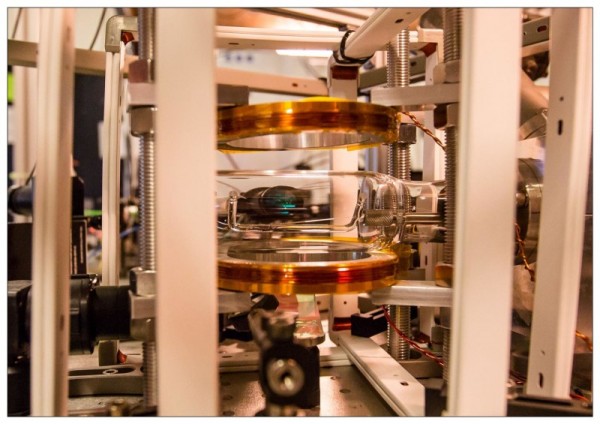Danish Researchers Trap Atoms to Develop Quantum Computer Networks
| Sami Ghanmi | | Jan 06, 2015 08:08 AM EST |
(Photo : Niels Bohr Institute) An ultra-thin glass fiber and a gas of cesium atoms
Researchers from the University of Copenhagen's Niels Bohr Institute have developed a new method that allows them to trap atoms along an ultra-thin glass fiber, furthering the development of quantum computer networks.
"We have an ultra-thin glass fiber with a diameter of half a micrometer." said Jürgen Appel, an associate professor for the Quantop research group at the institute.
Like Us on Facebook
"Along this glass fiber we capture cesium atoms. They are cooled down to 100 micro Kelvin using a laser -- this is almost absolute zero, which is equivalent to minus 273 degrees Celsius. This system acts like a trap that holds the atoms on the side of the glass fiber,"
Researchers carried out this experiment in the quantum optics laboratory located in the basement of the institute. This laboratory is located far away from the road to avoid vibrations emanating from traffic.
"We have developed a method where we can measure the number of atoms. We send two laser beams with different frequencies through the glass fiber. If there were no atoms on the fiber, the speed of light would be the same for both light beams." Appel added.
"However, the atoms affect the two frequencies differently and by measuring the difference in the speed of light for the two light beams on each side of the atoms' absorption lines, you can measure the number of atoms along the fiber. We have shown that we can hold 2,500 atoms with an uncertainty of just eight atoms,"
Appel said the method could be used for entangled states of atoms along the glass fiber. The entangled system can be used to develop future quantum computer networks.
TagsUniversity of Copenhagen, Niels Bohr Institute, Quantum Computer Networks, Denmark, Danish Researchers, Ulta-thin Glass Fiber, Quantum Optics Laboratory, Atoms
©2015 Chinatopix All rights reserved. Do not reproduce without permission
EDITOR'S PICKS
-

Did the Trump administration just announce plans for a trade war with ‘hostile’ China and Russia?
-

US Senate passes Taiwan travel bill slammed by China
-

As Yan Sihong’s family grieves, here are other Chinese students who went missing abroad. Some have never been found
-

Beijing blasts Western critics who ‘smear China’ with the term sharp power
-

China Envoy Seeks to Defuse Tensions With U.S. as a Trade War Brews
-

Singapore's Deputy PM Provides Bitcoin Vote of Confidence Amid China's Blanket Bans
-

China warns investors over risks in overseas virtual currency trading
-

Chinese government most trustworthy: survey
-

Kashima Antlers On Course For Back-To-Back Titles
MOST POPULAR
LATEST NEWS
Zhou Yongkang: China's Former Security Chief Sentenced to Life in Prison

China's former Chief of the Ministry of Public Security, Zhou Yongkang, has been given a life sentence after he was found guilty of abusing his office, bribery and deliberately ... Full Article
TRENDING STORY

China Pork Prices Expected to Stabilize As The Supplies Recover

Elephone P9000 Smartphone is now on Sale on Amazon India

There's a Big Chance Cliffhangers Won't Still Be Resolved When Grey's Anatomy Season 13 Returns

Supreme Court Ruled on Samsung vs Apple Dispute for Patent Infringement

Microsoft Surface Pro 5 Rumors and Release Date: What is the Latest?










